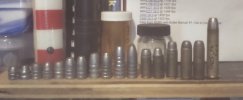358156 hp
At large, whereabouts unknown.
Hello Jim, and welcome. I've been reading and watching your thread with great interest. Fiver makes a couple of excellent points in post #29 that I'd like to expand on a bit. Iron moulds are often preferred by long range shooters for their consistency when casting. Once they are up to "operating" temperature and your alloy temps are stable, they can produce nearly identical bullets all day long once you get your rhythm down. I used to shoot handgun silhouette ages ago and found my greatest weight and overall quality consistency with iron moulds. I do have some aluminum moulds, but they are for 9mm class calibers, and are generally 4 cavity or larger. 9mm & such are rarely required to shoot sub-MOA so their quality is only secondary. Brass is a good option, but I've found them considerably fussier to work with until you break their spirit.
Long range buffalo rifle cast shooters I've know in the past all seemed to prefer single cavity iron moulds, cast by ladle. They also commonly used different weight bullets for different distances, the longer the distance, the heavier the bullet. For long range, bullet design is critical. MOA at 100 yards is a good start, but that particular design may not be anywhere close to that performance at 200 yards or beyond. Mass produced moulds like RCBS, Lyman, and the economical LEE probably won't deliver the performance you need. You'll also want very consistent alloy as you stretch your range. I don't remember if you specified which alloy you're using, but bitter experience has taught me that sometimes foundry sourced alloy is worth it.
If I may, there is a group of great guys I interact with occasionally that could certainly expand on the specifics better than I can. I confess to being a bit out of my league beyond the actual bullet related mechanics, so I'm not making any recommendations outside of my comfort zone. If you haven't contacted them yet you might visit the forum at American Single Shot Rifle Assn. at https://www.assra.com/
Long range buffalo rifle cast shooters I've know in the past all seemed to prefer single cavity iron moulds, cast by ladle. They also commonly used different weight bullets for different distances, the longer the distance, the heavier the bullet. For long range, bullet design is critical. MOA at 100 yards is a good start, but that particular design may not be anywhere close to that performance at 200 yards or beyond. Mass produced moulds like RCBS, Lyman, and the economical LEE probably won't deliver the performance you need. You'll also want very consistent alloy as you stretch your range. I don't remember if you specified which alloy you're using, but bitter experience has taught me that sometimes foundry sourced alloy is worth it.
If I may, there is a group of great guys I interact with occasionally that could certainly expand on the specifics better than I can. I confess to being a bit out of my league beyond the actual bullet related mechanics, so I'm not making any recommendations outside of my comfort zone. If you haven't contacted them yet you might visit the forum at American Single Shot Rifle Assn. at https://www.assra.com/

